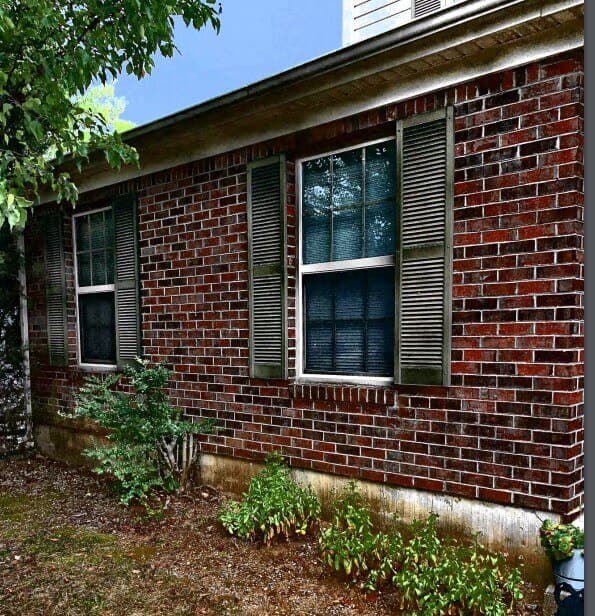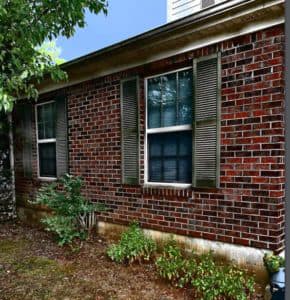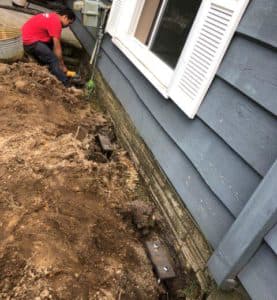
I think there’s a big difference between finding water in an unfinished basement and finding water in your bedroom closet. Having water intrusion in the main floor of your house has to be infinitely more alarming! But for homeowners with a slab foundation, it is a real and disruptive possibility.
The fact is: there aren’t any reliable waterproofing options for slab foundation homes. The traditional methods used in basements and crawl spaces aren’t reasonable solutions because they compromise the stability of your foundation (more on that in the next section). This makes preventative maintenance a high priority, if your home has a slab foundation.
Acculevel has been waterproofing homes and repairing foundations since our beginning in 1996. Our waterproofing methods are highly effective and come with the best warranty in the business- but they don’t work for a slab foundation. We want to help every homeowner who calls us, and it’s frustrating for both parties when we can’t. In this article, we’re going to explain what can be done to repair slab foundation homes, and best practices for homeowners to avoid water damage.
Before we begin, let’s clearly define what a slab foundation is. If your home has a basement or crawl space underneath it, you do not have a slab foundation. Your main floor is built on a wooden subfloor, with the slab part of your foundation in the basement. But If the main level of your home has a concrete floor, you have a slab foundation. Your house will sit at ground level or just above it, with only ductwork and plumbing below your concrete floor.
 This photo was taken by an Acculevel project manager during a free estimate. This slab foundation is settling, and needs piers and slabjacking to repair it.
This photo was taken by an Acculevel project manager during a free estimate. This slab foundation is settling, and needs piers and slabjacking to repair it.
In a basement or crawl space, waterproofing means installing a water drainage system and a sump pump. Water drainage in a basement requires breaking up the floor around the perimeter, installing the appropriate drainage tile, then recovering it. The drainage is routed to a pit (a hole dug into the floor), which holds the sump pump. As water drains into the pit, the pump moves it outside the house through a discharge line.
[box type="info"] For Clarification: unlike slab foundations, a basement floor is usually a piece separate from the foundation. We can break and re-pour it without compromising the stability of your home. On the rare occasion the floor and footings are all one piece (a monolithic foundation) traditional waterproofing isn’t an option in this situation either.[/box]
This doesn’t work in a home with a slab foundation. To begin with, breaking up the edge of the floor would mean your floor is no longer attached directly to your foundation. This can create settling issues with the slab, so you’d be trading one problem for another! It’s also likely that your ductwork for your HVAC system is under your floor, which would be compromised by water drainage installation. And even if neither of those would be an issue, I suspect you don’t want a sump pump pit in your kitchen or bathroom. Home remodeling shows like to highlight desirable features like granite countertops or heated floors- sump pump pits don’t make that list.
If there is water intruding into the ductwork itself, you will likely need to have those vents blocked off (usually by filling with cement) and the ductwork re-done. By relocating the ductwork to the attic and the vents to the ceilings, you resolve the issue and prevent it from happening again. But if water is getting into your home through a crack in the foundation, this may be something that can be repaired.
Your house will settle, no matter how well constructed. This is the result of the ground shifting under the weight of your house, along with changes in temperature and water saturation. (Basically, anything that affects the soil on your property can affect your house.)
Settling isn’t automatically an issue. However, if you start noticing
These are signs you have a settling problem.
There are two different repair methods for a slab foundation that is sinking. Depending on the situation and the location of the problem, either slabjacking or helical piers may be the best way to lift and/or stabilize your foundation.
If you have noticed a floor that is cracked or uneven, there’s a good possibility it needs to be lifted back into place. Slabjacking is a concrete lifting process that works quickly and efficiently. It uses a polyurethane fill that is injected through the slab; as it foams up and hardens, it lifts the concrete back into position. The time-lapse video below illustrates how slabjacking is done:
If you have noticed cracks around sticking windows/door, that’s an indication your foundation is settling either too far, or unevenly, creating stress throughout the structure. Helical piers are the best repair method for this type of issue.
In this video, we demonstrate how a pier is installed on a wall we built specifically for educational purposes:
 This photo was taken by an Acculevel crew member during pier installation. This slab foundation had settled, making it difficult for the homeowner to open his front door.
This photo was taken by an Acculevel crew member during pier installation. This slab foundation had settled, making it difficult for the homeowner to open his front door.
Because there’s no way to waterproof a slab foundation home, it is crucial that homeowners take steps to prevent water intrusion. There are three steps you can take, to minimize your risks:
You should find an experienced foundation company, and make an appointment. Before you sign a contract for any service, we urge you to always verify the company is reputable, insured, and accredited by the Better Business Bureau.
Is this your first time hiring a contractor? Not sure what questions to ask? Please use our blog about the questions to ask a contractor. The article gives you some insight into why you should ask these questions and provides Acculevel’s answers. It also comes with a free downloadable checklist of the questions you can use while interviewing any contractor you choose.
If you live in Indiana or the surrounding states, contact Acculevel. We can help you with everything from downspout extensions to helical piers, and we provide free estimates. An experienced project manager will examine the areas of concern and recommend the best course of action for you, to keep your home strong and healthy for years to come.
[DISPLAY_ULTIMATE_SOCIAL_ICONS]